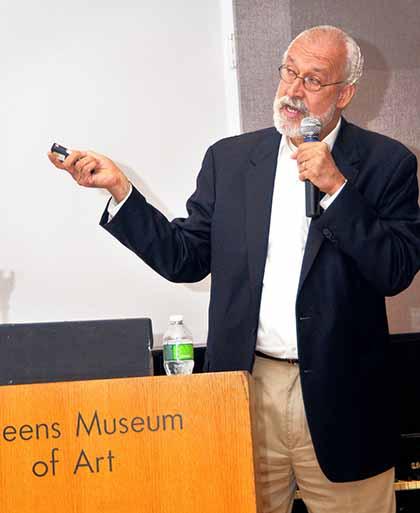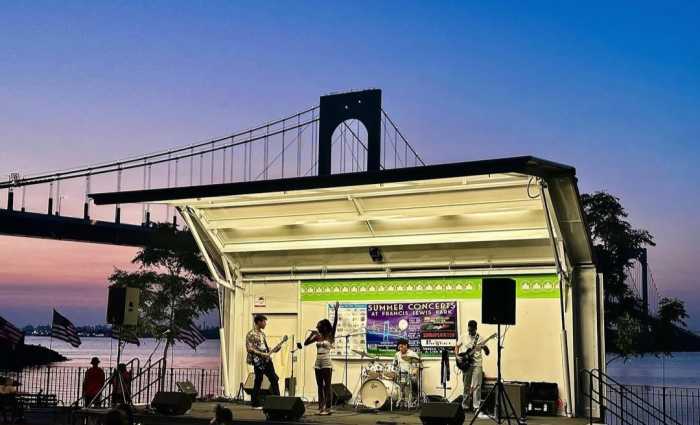By Anna Gustafson
As Haitians continue to seek life’s basics — shelter, food and clothing — six months after an earthquake devastated their island nation, little attention is being paid to the internationally known artwork and architecture that is slipping through the country’s hands. But Queens residents are hoping to highlight this loss with a new exhibit at the Queens Museum of Art.
Hundreds of borough and city residents attended “Haiti: A New Way of Life,” the exhibit that opened at the museum Saturday and shows about 40 works from Haitian artists ranging from the instrumental Jasmin Joseph, whose colorful paintings of fun-loving animals have established him as one of the greatest living Haitian artists, to Prefete Duffaut, one of the grand masters who saw much of his life’s work damaaged or destroyed in the earthquake.
Much of Haiti’s native paintings, sculptures and gingerbread architecture was damaged or completely destroyed in the earthquake that killed about 300,000 and left more than a million homeless. The opening, which included a panel discussion on Haiti’s architecture and the future of the country, was designed to draw attention to the vibrant works that show a country of great spirit and have long been celebrated by art lovers worldwide.
“We’re still in an emergency state in Haiti and it’s becoming more and more difficult to think about preserving our Haitian art and architecture, especially when people need food, shelter and medical care,” said Patricia Brintle, the exhibit’s curator who is a Whitestone painter originally from Haiti. “For the sake of our children, grandchildren and great grandchildren, we have to consider the preservation of our art and architecture. Art is Haiti’s calling, and so much of it has been lost, and so much architecture has been lost. It behooves us to take a good look at how we’re going to preserve what we have.”
The Smithsonian Institution, which is leading efforts to restore Haitian art, has said as many as 10,000 paintings and sculptures by prominent Haitian artists were lost when the Musee d’Art Nader collapsed in the earthquake. Countless other number of art pieces have been buried or destroyed, Smithsonian officials have said.
The 40 pieces at the Queens Museum of Art exhibit, which runs through Aug. 1, are organized by schools and major movements in Haiti, beginning with the Centre D’Art in 1944.
“There was an American, Dewitt Peters, went to Haiti to be a teacher and he looked for an art gallery but there were none,” said Brintle, who will return to her home country next month to work on restoring churches. “He opened the Centre D’Art and that catapulted Haitian art on the world market. So much talent was there.”
During the Saturday opening, three panelists discussed the future of Haiti, including an effort to green the country while memorializing those who died in the earthquake at the same time and the need to revamp the nation’s transportation infrastructure. Another speaker discussed the history of Haitian architecture.
Rodney Leon, a Manhattan-based architect whose family is from the capital, Port-au-Prince, has launched along with other Haitians the Hibiscus Memorial Project, an effort to plant hundreds of thousands of trees in Port-au-Prince in memory of those who died in the earthquake. This “sacred forest” will allow individuals to mourn those who they never truly got a chance to grieve over because of the sheer volume of the dead.
The idea is to connect the life of the person with the spirit of the tree,” Leon said.
Rudolf J. Geddeon, an engineer originally from Haiti, said it is crucial for his home country to rethink the way it handles transportation and create a sustainable system that allows sufficient space for various modes, such as buses and bicycles, throughout the country instead of concentrating much of its infrastructure efforts in Port-au-Prince, as had happened.
Anton Martinez, an architect from Haiti, gave a presentation on the history of Haitian architecture, a unique category often characterized by an emphasis on porches.
“We entertain on the porch, we live on the porch,” Martinez said.
Reach reporter Anna Gustafson by e-mail at agustafson@cnglocal.com or by phone at 718-260-4574.


































